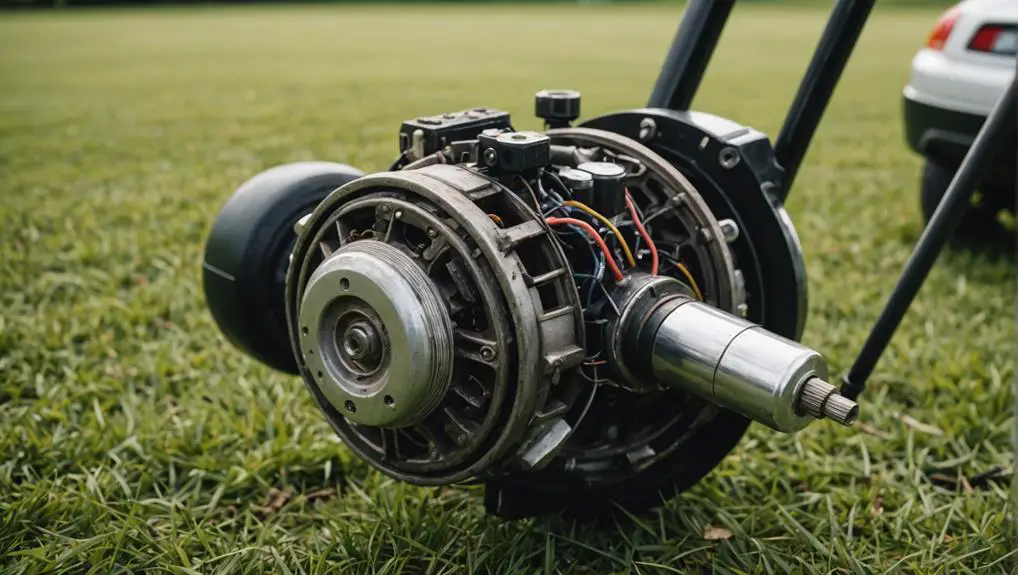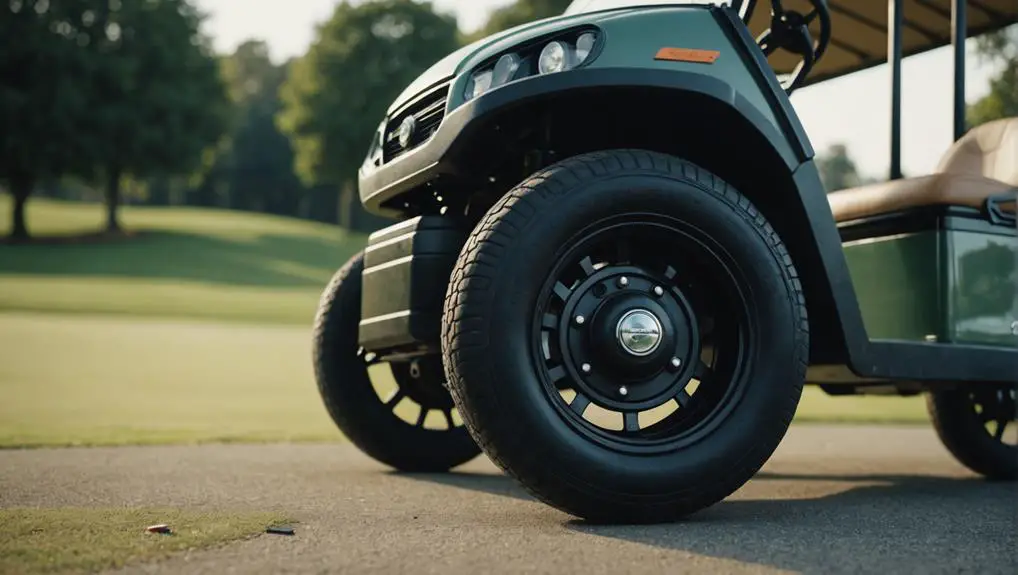Did you know that nearly 40% of electric golf cart issues stem from battery-related problems? If your cart won't move, it's essential to follow a systematic approach to pinpoint the cause. You might start by checking the battery charge level, but that's just the beginning. From battery connections to potential motor issues, each component plays an important role in your cart's functionality. Understanding these elements can greatly enhance your troubleshooting skills and get you back on the course faster. What's the first thing you should check?
Key Takeaways
- Check the battery charge level; low voltage can prevent the golf cart from moving.
- Inspect connections between the battery and controller for looseness or corrosion that can impede power flow.
- Verify the functionality of the motor by testing its voltage and looking for signs of overheating or unusual noises.
- Ensure the brake system is not engaged or malfunctioning, as this can stop the cart from moving.
- Examine wiring for damage or disconnections; frayed or pinched wires can disrupt electrical communication.
Battery Issues
When it comes to electric golf carts, battery issues are often the first culprits to investigate if you're experiencing performance problems.
Start by checking the charge level; a low battery can lead to insufficient power for movement. Use a multimeter to measure voltage. If the readings are below the manufacturer's specifications, it's time to recharge or replace the batteries.
Next, inspect the battery connections. Loose or corroded terminals can impede electrical flow, resulting in performance issues. Clean any corrosion with a mixture of baking soda and water, and tighten connections securely.
Additionally, consider the age and condition of the batteries. Most lead-acid batteries last around five to seven years. If your batteries are older, they may not hold a charge effectively, necessitating replacement.
Lastly, examine the water levels in your batteries if they're the flooded type. Low water levels can damage the cells. Always verify the water is just above the plates without overflowing.
Controller Problems
Controller problems can greatly impact your electric golf cart's performance, often manifesting as erratic acceleration or complete loss of power. The controller acts as the brain of your cart, managing the speed and direction based on your input. If it's malfunctioning, you might experience inconsistent responses when pressing the accelerator.
Start by checking the connections between the controller and the batteries. Loose or corroded connections can lead to voltage drops, causing erratic behavior. Inspect the controller for any visible signs of damage, such as burnt components or melted plastic. These issues might indicate internal failures, necessitating a replacement.
Next, verify the controller's programming. If your cart features a programmable controller, incorrect settings can lead to performance issues. Using manufacturer-specific diagnostic tools can help you reset or reprogram the controller as needed.
Lastly, confirm the controller's firmware is up to date. Manufacturers often release updates to improve performance and fix bugs.
If you've exhausted these troubleshooting steps and your cart still won't move, it may be time to consult a professional technician to perform a deeper diagnostic. Addressing controller problems swiftly can restore your cart's performance considerably.
Motor Malfunctions

Identifying motor malfunctions is essential for maintaining your electric golf cart's functionality. If your cart isn't moving, the motor might be the culprit. Here are three common motor issues to check:
- Overheating: Continuous use can lead to overheating, causing the motor to shut down temporarily. Make certain to give it adequate breaks.
- Insulation Damage: Frayed or damaged wires can lead to short circuits, impacting the motor's performance. Inspect the motor for any visible wear and tear.
- Brush Wear: The brushes inside the motor can wear down over time, leading to poor contact and power delivery. Regularly check and replace them as needed.
To troubleshoot motor malfunctions, start by testing the motor's voltage with a multimeter. Make sure it matches the specifications in your cart's manual.
Listen for unusual noises when you attempt to engage the motor; grinding or whining sounds may indicate internal damage. If you're unable to resolve the issue, consider consulting a professional technician.
Addressing motor malfunctions promptly can prevent further damage and make certain your golf cart operates smoothly.
Wiring and Connections
Motor malfunctions can often stem from faulty wiring and connections, which play a significant role in an electric golf cart's overall performance. Start by inspecting all wiring for visible signs of wear, fraying, or corrosion. A damaged wire can interrupt the electrical flow, preventing the motor from receiving power.
Check the connections at the battery, motor controller, and motor itself; loose or corroded connections can create resistance, leading to performance issues. Ensure that all connectors are tight and free of rust. If you notice any corrosion, clean it with a wire brush or replace the connector altogether.
Next, verify that the battery cables are securely attached and that the correct polarity is maintained. An improperly connected battery can lead to serious malfunctions. Also, examine the wiring harness for any pinched or broken wires, as these can disrupt communication between components.
Use a multimeter to test continuity in suspect wires. If you find any issues, repair or replace the affected wiring to restore proper function. Regular inspection and maintenance of wiring and connections will help prevent future problems and keep your golf cart running smoothly.
Brake System Checks

How can you guarantee your electric golf cart's brake system is functioning properly? A thorough brake system check is crucial for safety and performance. Here are three key steps to take into account:
- Inspect Brake Pads: Check the wear on the brake pads. If they're too thin or damaged, replace them immediately to guarantee effective stopping power.
- Examine Brake Cables: Look for any fraying or corrosion on the brake cables. Damaged cables can compromise the brake system's integrity and may require replacement.
- Test Brake Fluid: Verify the brake fluid is at the appropriate level and free of contaminants. Low or dirty fluid can lead to brake failure, so refill or replace if necessary.
After performing these checks, if you still notice issues with your cart not moving, the brake system might be seizing or malfunctioning.
Addressing these components early can prevent further complications down the line. Regular maintenance not only prolongs the life of your electric golf cart but also guarantees a safer driving experience.
Don't neglect these crucial aspects of your golf cart's functionality.
Frequently Asked Questions
How Can Weather Affect My Electric Golf Cart's Performance?
Weather can greatly affect your electric golf cart's performance. Cold temperatures can reduce battery efficiency, leading to diminished power and range.
High humidity or rain can cause electrical components to corrode or short-circuit, impacting functionality. Heat can strain the motor and batteries, causing overheating issues.
To maintain ideal performance, it's essential to store your cart in a climate-controlled environment and regularly inspect and maintain its components based on weather conditions.
What Maintenance Should I Perform Regularly to Prevent Movement Issues?
Think of your electric golf cart as a finely tuned instrument; regular maintenance keeps it playing smoothly.
To prevent movement issues, check the battery connections, clean the terminals, and guarantee the battery's charged.
Inspect the tires for proper inflation and tread wear.
Lubricate moving parts and test the brakes periodically.
Can Tire Pressure Impact the Movement of My Electric Golf Cart?
Yes, tire pressure can greatly impact your electric golf cart's movement. When tire pressure's too low, it increases rolling resistance, making it harder for the cart to move efficiently.
Conversely, over-inflated tires can lead to a rough ride and reduced traction. Regularly check and maintain your tires at the recommended pressure to guarantee peak performance.
Proper tire maintenance not only enhances movement but also extends tire life and improves overall safety.
Are There Specific Signs of Wear to Watch for in Electric Carts?
Think of your electric golf cart like a trusty steed. Just like a horse, it shows signs of wear that you shouldn't ignore.
Look out for worn tires, frayed cables, or corrosion on the battery terminals. Pay attention to unusual noises or sluggish movement, as these could indicate mechanical issues.
Regularly inspect the brakes and suspension components too; any imbalance can lead to bigger problems down the road. Keeping an eye on these signs guarantees longevity.
How Often Should I Replace My Golf Cart's Battery for Optimal Performance?
You should replace your golf cart's battery every 4 to 6 years for peak performance.
However, monitor your battery's health regularly. If you notice decreased power, longer charging times, or physical signs of wear, it might be time for a replacement sooner.
Keep track of the number of cycles and maintenance; consistent care can extend battery life.
Ultimately, staying proactive guarantees your cart runs efficiently and reliably throughout its lifespan.
Conclusion
To summarize, troubleshooting an electric golf cart that won't move involves a careful examination of the battery, controller, motor, wiring, and brake system. Remember, about 30% of golf cart issues stem from battery problems, so start there. By systematically checking each component, you can identify and resolve the issue efficiently. Don't overlook the importance of secure connections and regular maintenance to keep your cart running smoothly. With diligence, you'll have your golf cart back in action in no time.